A Guide to Crafting a Branding Board
Have difficulty creating an impactful and consistent brand identity that resonates with your desired customers? You’ve come to the right place! This guide will take you through what a branding board is, its vital components, as well as useful resources to craft a killer brand identity. Follow this resource for guidance on developing an exclusive look and feel of your business in order to stand out from competitors.
Short Summary
- A branding board is a visual bible that outlines logos, fonts & colors to create an easily recognizable brand identity.
- It is composed of logos, color palettes, typography & patterns/textures.
- Staff training and regular reviews are essential for maintaining consistency.
- Check out successful examples to learn how to craft your perfect brand identity!
Understanding the Purpose of a Branding Board
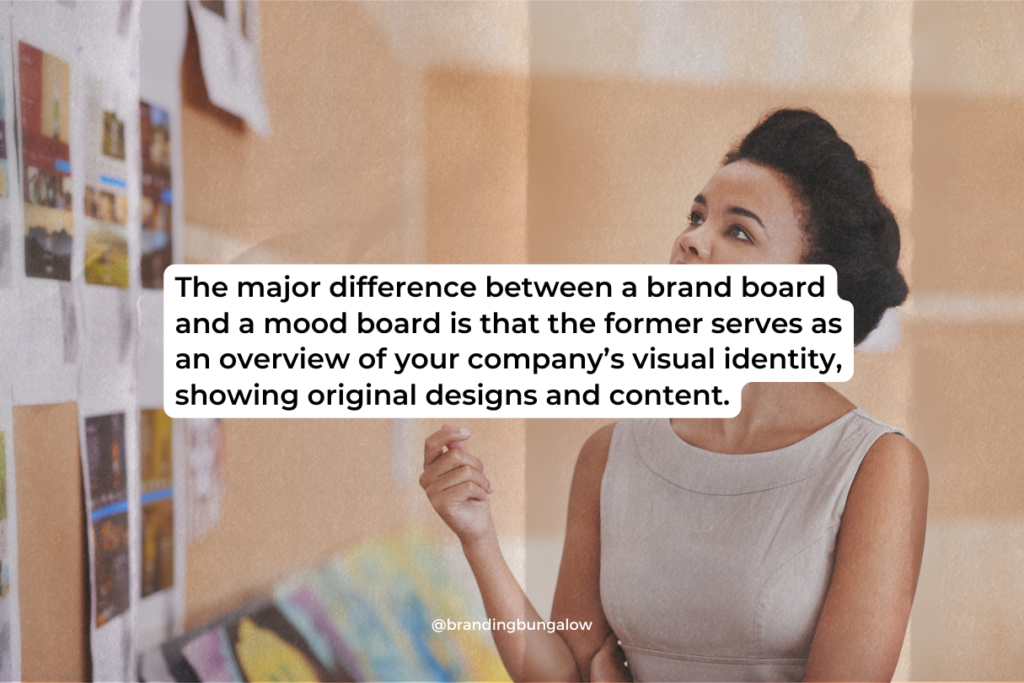
A brand board is a visual guidebook of branding elements such as logos, fonts and colors for defining your business’s identity. Sticking to the same style helps consumers remember and trust you better. While having an effective strategy around it helps maintain consistency across departments & projects. Checking out successful examples combined with customer feedback can give useful insights into the perception of your company’s branding. If there are gaps, modifying the physical board accordingly would be beneficial in enhancing recognition. Overall, by creating and consistently maintaining strong brand boards will significantly bolster one’s presence within their marketplace.
Difference between branding board and mood board
The major difference between a brand board and a mood board is that the former serves as an overview of your company’s visual identity, showing original designs and content. A mood board, on the other hand, provides inspiration to develop this concept into something tangible: it enables you to create a brand so all branding efforts are consistent with one another. In short, think of your mood boards like ideas at the brainstorming stage while we find finished products such as logos in branding boards.
Essential Elements of a Branding Board
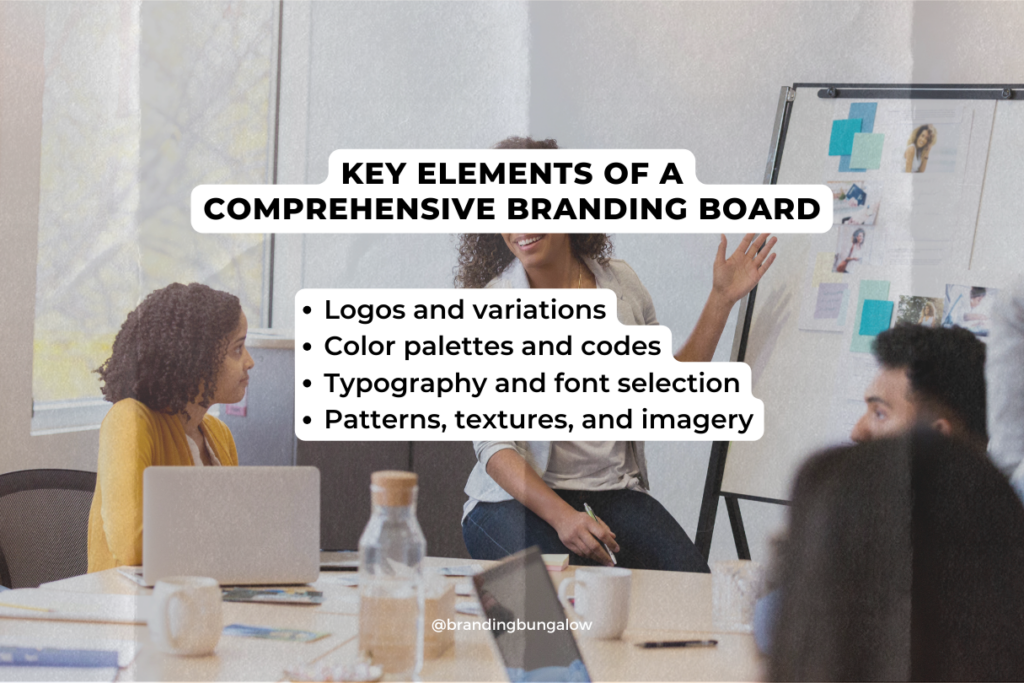
To gain a better understanding of the importance of having a comprehensive branding board, let’s take an in-depth look at its key elements. All visual components included in the creative board greatly enhance the brand identity . Logos, color palettes, typography and textures/patterns are fundamental for producing consistent results to represent your company’s or organization’s unique image.
It would be beneficial to analyze each component separately so we can get closer to constructing distinctive visuals associated with our desired brand. Logos will serve as representation while colors bring distinction between various sections. Text fonts to texture style designs such as webs and grids can also come into play depending on product type. This supports creating memorable visibility throughout any platform which helps build recognition even more quickly over time.
Logos and Variations
Creating a strong brand identity begins with designing an effective main logo. This is why it’s important to include alternative versions of your symbol in the process, such as submarks and favicons. This will guarantee that whatever platform or medium you use for promotion has its own visually consistent version of the same logo design. You can use these different forms in other ways, like as watermarks or even part of patterns/highlight covers on Instagram! Having multiple types gives more flexibility when showcasing your branding.
Color Palette and Codes
Brand colors have a big role to play in the identity and emotional triggers of any brand. Utilizing color palettes containing hex codes, Pantone swatches and RGB/CMYK values helps maintain consistency between both print and digital materials. By systematically integrating these tones into all marketing content it will create an easily identifiable branded presence throughout various sources.
To uncover great palettes for your branding needs, explore websites such as Design Seeds, Colourlovers or Coolors that offer abundant options for you to choose from!
Typography and Font Selection
Font selection and typography play a big part in creating your brand identity, as these features give you the power to demonstrate its personality through headlines, subheadings and body copy. Good design guidelines recommend using only two or three fonts to keep things clean-cut and professional. The primary font should primarily serve stationery needs such as posters while secondary can add accents on specific points of content if desired.
When drafting up a branding board with text elements included, think about how diverse types of typefaces may portray certain traits related to your company’s image. Customized styles could also be uploaded into the mix for extra flare during campaigns or other multimedia operations like social media posts etc.
Patterns, Textures, and Imagery
Graphic elements, such as icons, call-outs and features from the logo, can be used to create a unified brand identity throughout all marketing materials. Visual devices like borders are also powerful visual tools which help communicate your brand’s personality across different platforms. When selecting patterns, textures and imagery for branding boards, it is important that they fit with your company’s style in order to ensure consistency of look and feel within all campaigns.
Creating Your Branding Board: Tools and Techniques
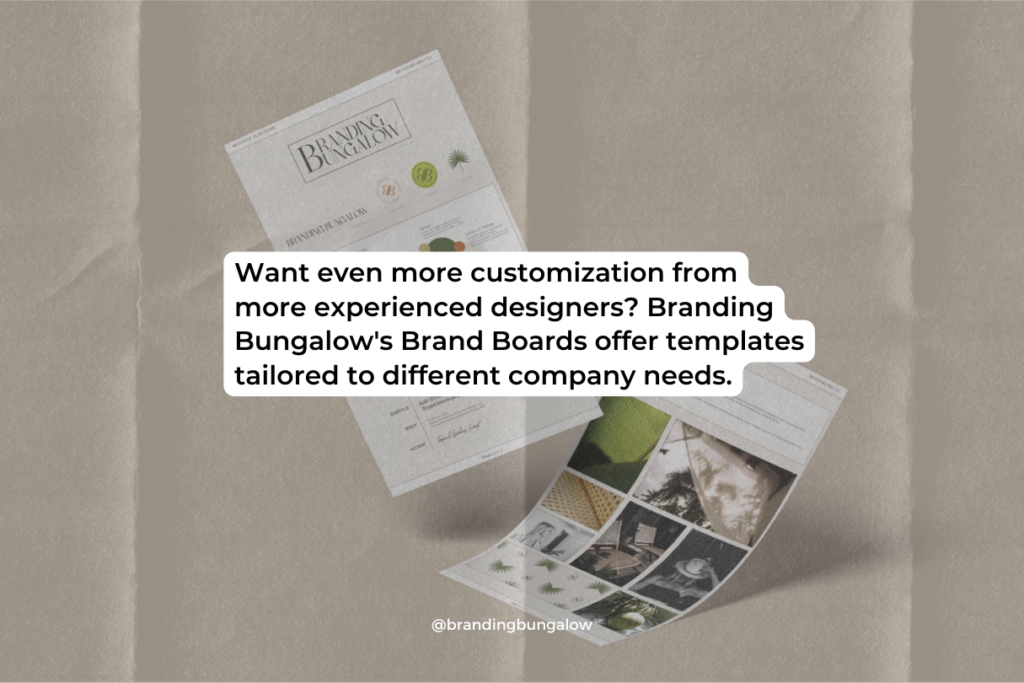
After examining the core components of a branding board, we should investigate all available tools and techniques for putting one together. Free templates to design software or even hiring an expert designer are some great choices that depend on individual preferences and finances.
The purpose behind this is always identical: making sure the whole product shows off cohesiveness along with strong aesthetic appeal regardless of which method you decide upon in creating your branding board.
Free Brand Board Templates
For those looking to construct a brand board on an affordable budget, we recommend using a free template. Canva provides various templates that enable you to craft your branding board with ease and efficiency by providing pre-configured design elements such as logos, fonts, and colors. But if there’s desire for unique font types or other special features of the brand, then one must have access to Canva Pro in order for it all to come together harmoniously. Its user friendly interface helps make assembling professional branded boards feasible even without prior experience doing so!
Design Software Options
For those seeking more advanced design software, consider Canva, Adobe Photoshop, Illustrator and InDesign. All of these have varying levels of complexity to fulfill your needs in terms of creating designs. For example, use Adobe Photoshop for editing images and Adobe Illustrator for designing logos and illustrations. Similarly, utilize InDesign to create documents such as brochures or magazines.
Professional Brand Board Templates
Unsure of where to begin or want a professional template to kick-start your brand? Creative Market has brand board templates available designed by independent designers that could give greater personalization capabilities.
If you want even more customization from more experienced designers, Branding Bungalow’s Brand Boards offer templates tailored to different company needs, like this Editorial Brand Board aimed at service-based businesses, or even this Timeless Brand Board for influencers and product-based businesses.
Professional brand board templates are the perfect choice if you need help producing unique materials branded uniquely on behalf of your business/organization.
Implementing Your Branding Board Across Marketing Materials
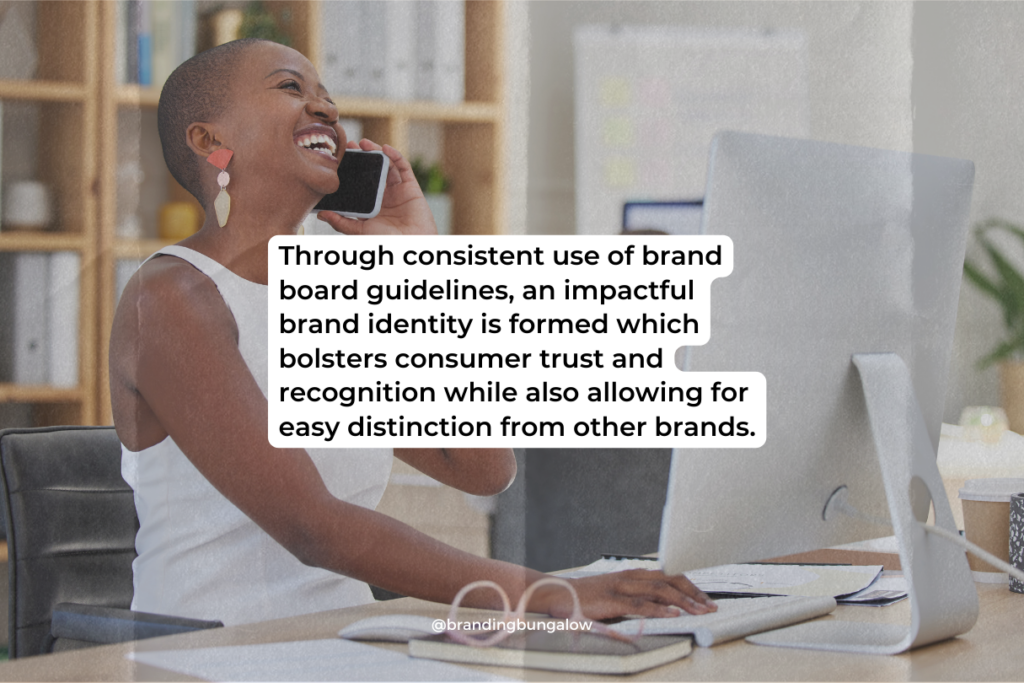
Adhering to the elements of your branding board across all marketing materials is essential in creating a unified brand look and feel that resonates with customers. Through consistent use of these guidelines, an impactful brand identity is formed which bolsters trust and recognition within your target audience while also allowing for easy distinction from other brands. Ultimately, this will be beneficial towards long-term growth by forming lasting relationships between you and those engaging with the content related to it.
Print Materials
Consistency in logos, colors and typography is essential when creating business cards, brochures and flyers for your brand. It will ensure that these promotional items are representing the branding board’s guidelines correctly while leaving a lasting impression on potential customers. To make sure you stay within those parameters, it’s important to review them periodically so any necessary changes can be implemented immediately. Doing this helps maintain an effective representation of what your company stands for among current or future clients alike.
Digital Assets
When creating a unified brand identity to appeal to your intended audience, it’s important that digital assets such as websites and social media profiles follow the directions of your branding board. This includes making sure all logos, colors, typography patterns and textures are consistent across each asset in order for them to remain linked together with the same recognizable image. Regularly assessing these details will help ensure they stay current alongside any changes made in regards to your evolving brand identity.
Maintaining Brand Consistency: Tips for Success
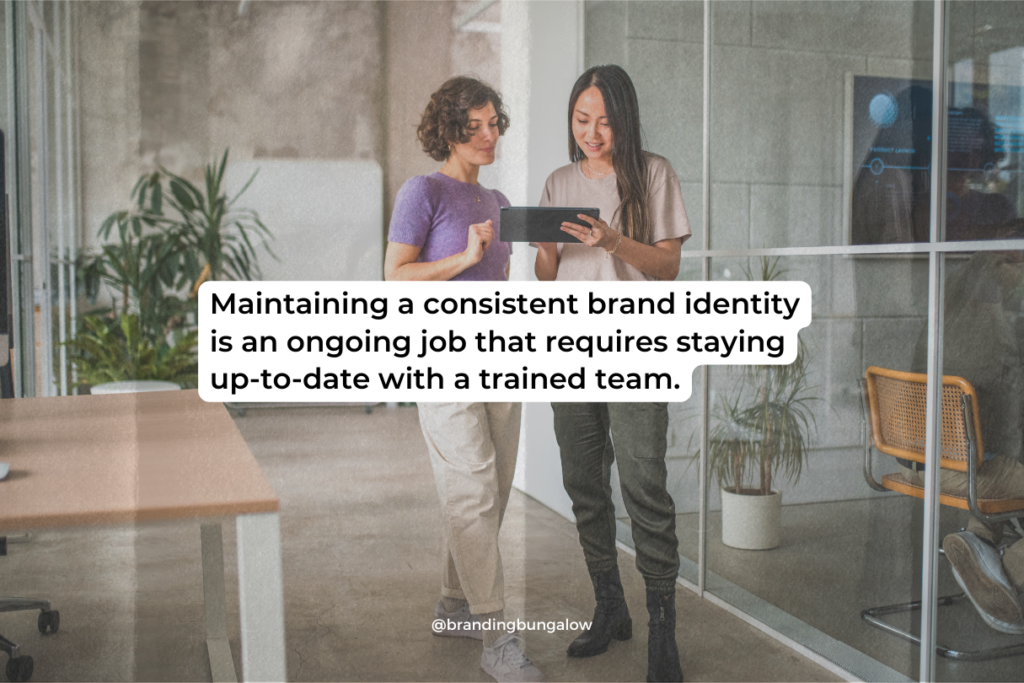
Maintaining a consistent brand identity is an ongoing job, and these steps should be taken in order to ensure success. For starters, it’s important to get the team involved by training them on what your branding entails as well as keeping up-to-date with any new members who join you along the way. Also, making sure that the ‘brand board’ remains accurate & regularly reviewed would help guarantee continuous consistency throughout. These actions will ultimately result in strengthening your overall image & having a unified message that resonates across all audiences!
Staff Training and Onboarding
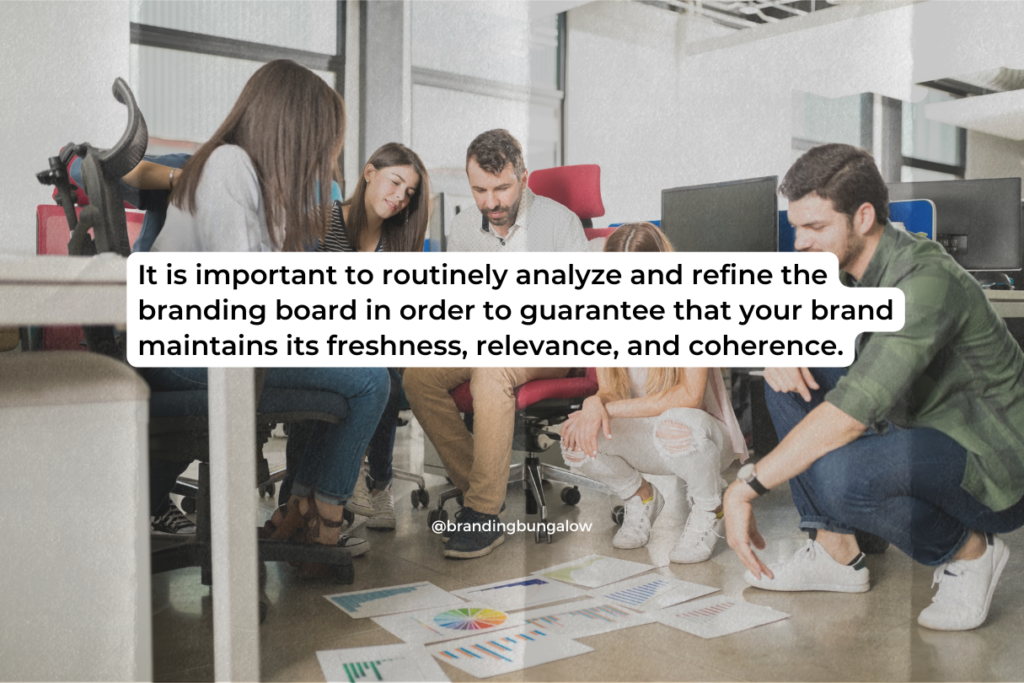
Successful brand integration can be secured through effective staff training and onboarding. All team members must understand the expectations for performance, communication, and collaboration that have been set by the branding board to ensure consistency in their work output. To expedite this process of instilling company values into new hires, having a mentor or partner available during the first 90 days helps them develop crucial skills quicker than without any assistance at all.
Regular Reviews and Updates
It is important to routinely analyze and refine the branding board in order to guarantee that your brand maintains its freshness, relevance, and coherence. Examining both the current version of your corporate identity as well as assessing how successful it has been can help you identify possible room for improvement. This includes adjusting logos, colors schemes/palettes, typography choices, patterns & textures used on materials across channels or visuals associated with campaigns.
Following these tips while consistently updating content throughout each step of constructing a branding board will ensure that you remain at an advantageous position which allows for consistency between interactions made with customers through various mediums allowing them access to captivating experiences involving said brand’s image.
Case Studies: Successful Branding Board Examples
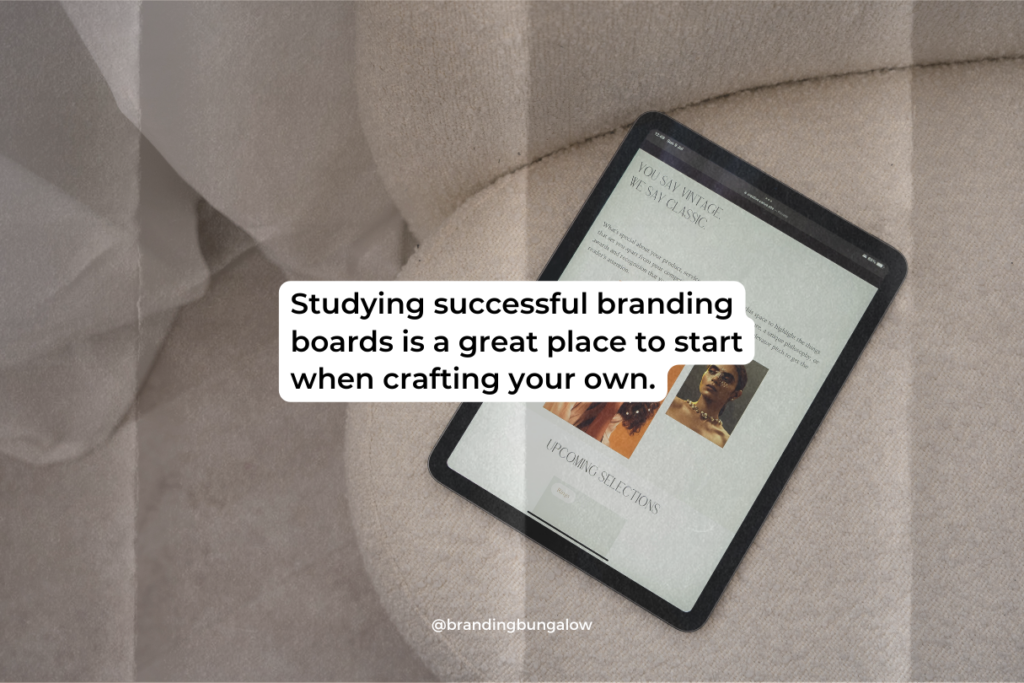
Studying successful branding boards is a great place to start when crafting your own. Examining the use of logos, colors, typography, patterns and textures across various marketing materials in these examples can help you create an effective brand board that resonates with customers and develops strong identity recognition.
For instance, some inspiring brands include Coffee Branding Concept, Blooma Floral Studio, Branding Addicts, and even Little Yellow Leaf’s vegan & organic raspberry offering. Each uses their identities effectively for maximum impact on the market. All this underscores how important it is to apply consistent visuals throughout all messaging channels within any given brand’s strategy if they hope to make headway into success!
Summary
Creating a branding board is an effective way of building and maintaining brand identity that connects with your target audience. By recognizing the value of such boards, factoring in crucial elements, utilizing relevant tools and techniques, as well as preserving consistent brand messaging, you can make sure to set yourself apart from other competitors. Take advantage of this highly successful approach for constructing strong brands which are able to engage viewers both effectively and memorably.
Frequently Asked Questions
What is a branding board?
A branding board is a document that provides an overview of all the graphic elements and visual components associated with a brand, such as its logo, colors, typography style and other visuals like textures, patterns or pictures. This compilation visually presents what comprises the identity of the company.
What should be included in a branding board?
A brand board is a handy resource for all the important visual aspects of a brand, from its logo to colors and typography to graphics. It should be easy-to-read so one can quickly look up any component related to their branding—allowing them access to every part of what makes up their company’s identity in an instant.
What are brand boards used for?
Brand boards serve as a useful visual reference point for your brand’s distinct aesthetic and visual identity, displaying symbols like the logo, fonts used in text layout, different color schemes within the palette available to you, variations of these items (submarks), patterns or textures that could be included into images, all designed to establish consistency throughout every piece of marketing materials representing your business.
It helps keep things recognizable at-a-glance so it is easier to communicate with clarity about who you are and what message can potential customers expect from engaging with your branding elements.
How many fonts should I include in my branding board?
It is advisable to include two or three fonts in your branding board for a polished visual appearance. This will help maintain consistency and keep the desired aesthetic you are going for intact.
Where can I find branding board templates?
Canva provides free templates with minimal customization. For even greater personalization capabilities to your brand, seek Creative Market or the more professional Branding Bungalow’s Brand Boards.
Recent Blog Entries
Discounts to Dubsado CRM, Helcim Payment Processing and...
Brand audits can save your business' sinking marketing ship.
What's happening to Coke and what you can learn from it.
Shop Products
Create a personalize brand board by taking elements from our 3 signature brand board templates.